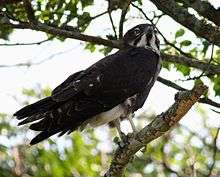Bat hawk
| Bat hawk | |
|---|---|
 | |
| Bat hawk at Cape Vidal, Northern Natal, South Africa | |
| Scientific classification | |
| Kingdom: | Animalia |
| Phylum: | Chordata |
| Class: | Aves |
| Order: | Accipitriformes |
| Family: | Accipitridae |
| Genus: | Macheiramphus Bonaparte, 1850 |
| Species: | M. alcinus |
| Binomial name | |
| Macheiramphus alcinus Bonaparte, 1850 | |
| Subspecies | |
|
M. a. andersonii M. a. alcinus M. a. papuanus | |
| | |
| Synonyms | |
|
Machaerhamphus alcinus Westerman, 1851 | |
The bat hawk (Macheiramphus alcinus) is a raptor found in sub-Saharan Africa and south Asia to New Guinea. It is named for its diet, which consists mainly of bats.[2] It requires open space in which to hunt, but will live anywhere from dense rainforest to semi-arid veld.
Description
The bat hawk is a slender, medium-sized bird of prey, usually about 45 cm long. It has long wings and a falcon-like silhouette. Adults are dark brown or black, with a white patch on the throat and chest, and have a white streak above and below each eye. Juveniles are mottled brown and have more white plumage than adults.
Behaviour
Hunting
Bats are the usual prey of the bat hawk, although they may eat small birds, such as swallows, swifts, and nightjars, or even insects. They hunt by chasing their prey at high speeds in flight. About 49% of their hunts are successful.[3]
The bat hawk is crepuscular and hunts at dusk.
Breeding
Courtship involves many aerial displays and stunts. The nest is built with sticks gathered in flight, and is about 90 cm across and 30 cm deep.[4] The female is solely responsible for incubating her clutch. The male often shares food with her. About a month after incubation begins, the eggs hatch, and both parents help to feed their young. 30–45 days after hatching, the young fledge. They leave the nest soon after.
Bat hawks breed most years.
Conservation
Due to its large range and relatively stable population, the bat hawk is of least concern.[1]
Etymology
The genus name is from Greek: μαχαιρα makhaira meaning knife; and ῥαμφος rhamphos, bill. The specific epithet alcinus means like an auk, from Linnaeus' genus Alca, which is also a reference to the bat hawk's thin bill.[5]
Taxonomy
The spelling of the genus name is problematic. Charles Lucien Bonaparte described the bat hawk in 1850, naming it Macheiramphus alcinus.[6](pp482–483) Westerman described it in 1851 under the name Machaerhamphus alcinus, and this form was used for over a hundred years because it was believed to have been published in 1848. In 1960 Deignan pointed out that Bonaparte has priority, but in 1979 Amadon claimed that Macheiramphus alcinus is an abandoned name. Brooke and Clancey note that the preservation of a junior synonym requires a special ruling from the ICZN that Amadon didn't obtain; whilst Dickinson argues that Deignan's resurrection of the name in 1960 should stand because it predates the first edition of the Code in 1961.[7][8]
References
- 1 2 BirdLife International (2013). "Macheiramphus alcinus". IUCN Red List of Threatened Species. Version 2013.2. International Union for Conservation of Nature. Retrieved 26 November 2013.
- ↑ Mikula, P., Morelli, F., Lučan, R. K., Jones, D. N., & Tryjanowski, P. (2016). Bats as prey of diurnal birds: a global perspective. Mammal Review.
- ↑ H. L. Black, G. Howard, R. Stjernstedt. (1979). Observations on the Feeding Behavior of the Bat Hawk. Biotropica, Vol. 11, No. 1, pp. 18-21
- ↑ The Hawk Conservancy Trust (1996-2007). Bat Hawk. Retrieved April 16, 2007, from http://www.hawk-conservancy.org/priors/bathawk.shtml
- ↑ Jobling, James A. (2014). "Key to Scientific Names in Ornithology". Handbook of the Birds of the World Alive. Lynx Edicions. Retrieved 31 October 2014. See entries Machieramphus and alcinus.
- ↑ Bonaparte, Charles-Lucien (1850). "Revue générale de la classe des oiseaux". Revue et Magasin de Zoologie Pure et Appliquée (in French). 2 (2): 474–492. Retrieved 31 October 2014.
- ↑ Brooke, R. K.; Clancey, P. A. (1981). "The Authorship of the Generic and Specific Names of the Bat Hawk". Bulletin of the British Ornithologists' Club. 101 (4): 371–372. Retrieved 28 October 2014. text, PDF
- ↑ Peterson, Alan P. (2013). "Zoonomen Nomenclatural data". Retrieved 28 October 2014.
